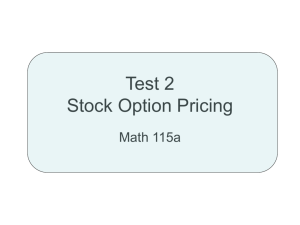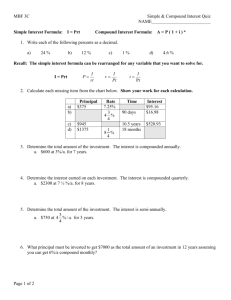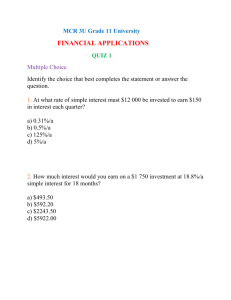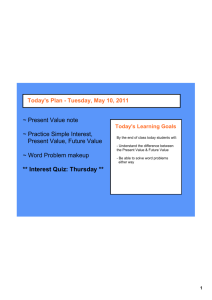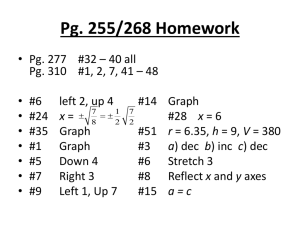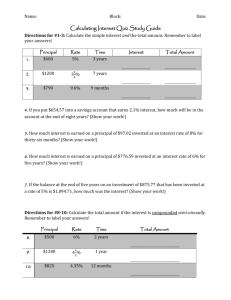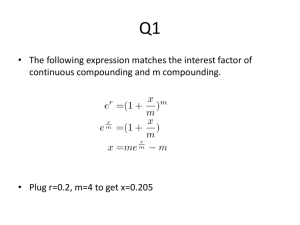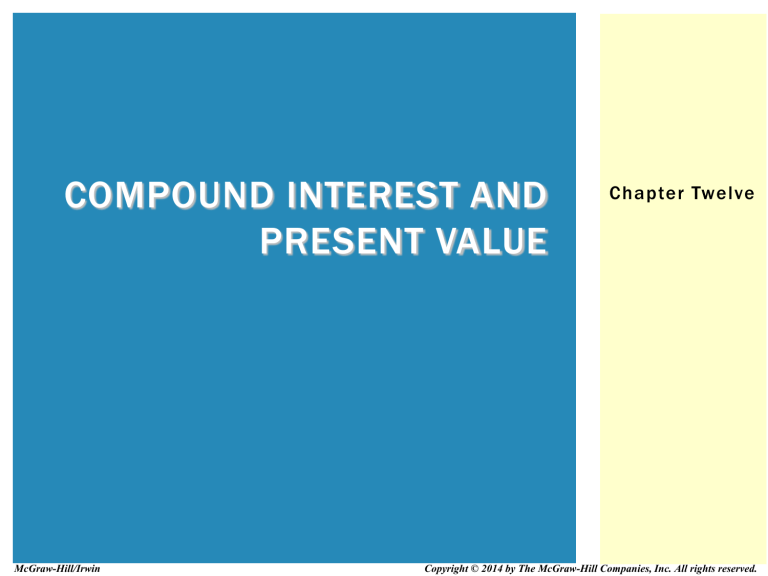
COMPOUND INTEREST AND
PRESENT VALUE
McGraw-Hill/Irwin
Chapter Twelve
Copyright © 2014 by The McGraw-Hill Companies, Inc. All rights reserved.
LEARNING UNIT OBJECTIVES
LU 12-1 Compound Interest (Future Value) – The Big Picture
1.
Compare simple interest with compound interest.
2.
Calculate the compound amount and interest manually and by
table lookup.
3.
Explain and compute the effective rate (APY).
LU 12-2 Present Value -- The Big Picture
1.
Compare present value (PV) with compound interest (FV).
2.
Compute present value by table lookup.
3.
Check the present value answer by compounding.
12-2
COMPOUNDING INTEREST
(FUTURE VALUE)
Compounding –
Compound Interest –
Involves the calculation of interest
periodically over the life of the loan or
investment
The interest on the principal plus the
interest of prior periods
Future Value (compound amount) –
Present Value –
The final amount of the loan or
investment at the end of the last
period
The value of a
loan or investment today
12-3
COMPOUNDING TERMS
Compounding Periods
Interest Calculated
Compounding Annually
Once a year
Compounding Semiannually
Every 6 months
Compounding Quarterly
Every 3 months
Compounding Monthly
Every month
Compounding Daily
Every day
12-4
FUTURE VALUE OF $1 AT 8% FOR FOUR
PERIODS (FIGURE 12.1)
Compounding goes from present value to future value
$5.00
$4.50
$4.00
$3.50
$3.00
$2.50
$2.00
$1.50
$1.00
$0.50
$0.00
Future
Value
Present
value
$1.00
0
After 1
period,
$1 is
worth
$1.08
After 2
periods,
$1 is
worth
$1.17
$1.08
$1.1664
1
2
Number of periods
After 3
periods,
$1 is
worth
$1.26
After 4
periods,
$1 is
worth
$1.36
$1.2597
$1.3605
3
4
12-5
FUTURE VALUE OF $1 AT 8% FOR
FOUR PERIODS (FIGURE 12.1)
Manual Calculation
Year 1
Year 2
Year 3
Year 4
$
1.00 $
1.08 $
1.17 $
1.26
0.08
0.08
0.08
0.08
Interest
$
0.08 $
0.09 $
0.09 $
0.10
Beg. Bal
1.00
1.08
1.17
1.26
End of year $
1.08 $
1.17 $
1.26 $
1.36
12-6
TOOLS FOR CALCULATING
COMPOUND INTEREST
Number of periods (N)
Number of years multiplied by
the number of times the
interest is compounded per
year
Rate for each period (R)
Annual interest rate divided by
the number of times the
interest is compounded per year
If you compounded $100 for 4 years at 8% annually,
semiannually, or quarterly, what is N and R?
Periods
Rate
Annually:
4x1=4
Annually:
8% / 1 = 8%
Semiannually:
4x2=8
Semiannually:
8% / 2 = 4%
Quarterly:
4 x 4 = 16
Quarterly:
8% / 4 = 2%
12-7
SIMPLE VERSUS COMPOUND INTEREST
Simple
Compounded
Bill Smith deposited $80 in a savings
account for 4 years at an annual
interest rate of 8%. What is Bill’s
simple interest and maturity value?
I=PxRxT
I = $80 x .08 x 4
I = $25.60
MV = $80 + $25.60
MV = $105.60
Bill Smith deposited $80 in a savings
account for 4 years at an annual
interest rate of 8%. What is Bill’s
interest and compounded amount?
Year 1
Year 2
Year 3
Year 4
$
80.00 $ 86.40 $ 93.31 $ 100.77
x .08
x .08
x .08
x .08
Interest
$
6.40 $
6.91 $
7.46 $
8.06
Beg. bal
80.00
86.40
93.31
100.77
End of year $
86.40 $ 93.31 $ 100.77 $ 108.83
Interest: $108.83 -- $80.00 = $28.83
12-8
CALCULATING COMPOUND AMOUNT
BY TABLE LOOKUP
Step 1. Find the periods: Years multiplied by number of times
interest is compounded in 1 year.
Step 2. Find the rate: Annual rate divided by number of times
interest is compounded in 1 year.
Step 3. Go down the period column of the table to the number
desired; look across the row to find the rate. At the
intersection is the table factor for the compound amount of
$1.
Step 4. Multiply the table factor by the amount of the loan. This
gives the compound amount.
12-9
FUTURE VALUE OF $1 AT COMPOUND
INTEREST (TABLE 12.1)
Future value of $1 at compound interest (Partial)
Period
1%
1.50%
2%
3%
4%
5%
6%
7%
8%
9%
10%
1
1.0100
1.0150
1.0200
1.0300
1.0400
1.0500
1.0600
1.0700
1.0800
1.0900
1.1000
2
1.0201
1.0302
1.0404
1.0609
1.0816
1.1025
1.1236
1.1449
1.1664
1.1881
1.2100
3
1.0300
1.0457
1.0612
1.0927
1.1249
1.1576
1.1910
1.2250
1.2597
1.2950
1.3310
4
1.0406
1.0614
1.0824
1.1255
1.1699
1.2155
1.2625
1.3108
1.3605
1.4116
1.4641
5
1.0510
1.0773
1.1041
1.1593
1.2167
1.2763
1.3382
1.4026
1.4693
1.5386
1.6105
6
1.0615
1.0934
1.1262
1.1941
1.2653
1.3401
1.4185
1.5007
1.5869
1.6771
1.7716
7
1.0721
1.1098
1.1487
1.2299
1.3159
1.4071
1.5036
1.6058
1.7138
1.8280
1.9487
8
1.0829
1.1265
1.1717
1.2668
1.3686
1.4775
1.5938
1.7182
1.8509
1.9926
2.1436
9
1.0937
1.1434
1.1951
1.3048
1.4233
1.5513
1.6895
1.8385
1.9990
2.1719
2.3579
10
1.1046
1.1605
1.2190
1.3439
1.4802
1.6289
1.7908
1.9672
2.1589
2.3674
2.5937
11
1.1157
1.1780
1.2434
1.3842
1.5395
1.7103
1.8983
2.1049
2.3316
2.5804
2.8531
12
1.1260
1.1960
1.2682
1.4258
1.6010
1.7959
2.0122
2.2522
2.5182
2.8127
3.1384
13
1.1381
1.2135
1.2936
1.4685
1.6651
1.8856
2.1329
2.4098
2.7196
3.0658
3.4523
14
1.1495
1.2318
1.3195
1.5126
1.7317
1.9799
2.2609
2.5785
2.9372
3.3417
3.7975
15
1.1610
1.2502
1.3459
1.5580
1.8009
2.0789
2.3966
2.7590
3.1722
3.6425
4.1772
12-10
CALCULATING COMPOUND AMOUNT
BY TABLE LOOKUP
Pam Donahue deposits $8,000 in her savings account that pays 6%
interest compounded quarterly. What will be the balance of her
account at the end of 5 years?
Periods (N) = 4 x 5 = 20
Rate (R) = 6%/4 = 1.5%
Table Factor = 1.3469
Compounded Amount:
$8,000 x 1.3469 = $10,775.20
12-11
NOMINAL AND EFFECTIVE RATES (APY)
OF INTEREST
Nominal Rate (stated rate) –
The rate on which the bank calculates interest
Effective rate (APY) = Interest for 1 year
Principal
12-12
CALCULATING EFFECTIVE RATE APY
12-13
NOMINAL AND EFFECTIVE RATES (APY)
OF INTEREST COMPARED (FIGURE 12.3)
12-14
COMPOUNDING INTEREST DAILY
(TABLE 12.2)
Interest on a 1% deposit compounded daily--360 day basis
Period
6.00%
6.50%
7.00%
7.50%
8.00%
8.50%
9.00%
9.50%
10.00%
1
1.0618
1.0672
1.0725
1.0779
1.0833
1.0887
1.0942
1.0996
1.1052
2
1.1275
1.1388
1.1503
1.1618
1.1735
1.1853
1.1972
1.2092
1.2214
3
1.1972
1.2153
1.2337
1.2523
1.2712
1.2904
1.3099
1.3297
1.3498
4
1.2712
1.2969
1.3231
1.3498
1.3771
1.4049
1.4333
1.4622
1.4917
5
1.3498
1.3840
1.4190
1.4549
1.4917
1.5295
1.5862
1.6079
1.6486
6
1.4333
1.4769
1.5219
1.5682
1.6160
1.6652
1.7159
1.7681
1.8220
7
1.5219
1.5761
1.6322
1.6904
1.7506
1.8129
1.8775
1.9443
2.0136
8
1.6160
1.6819
1.7506
1.8220
1.8963
1.9737
2.0543
2.1381
2.2253
9
1.7159
1.7949
1.8775
1.9639
2.0543
2.1488
2.2477
2.3511
2.4593
10
1.8220
1.9154
2.0136
2.1168
2.2253
2.3394
2.4593
2.5854
2.7179
15
2.4594
2.6509
2.8574
3.0799
3.3197
3.5782
3.8568
4.1571
4.4808
20
3.3198
3.6689
4.0546
4.4810
4.9522
5.4728
6.0482
6.6842
7.3870
25
4.4811
5.0777
5.7536
6.5195
7.3874
8.3708
9.4851
10.7477
12.1782
30
6.0487
7.0275
8.1645
9.4855
11.0202
12.8032
14.8747
17.2813
20.0772
12-15
COMPOUNDING INTEREST DAILY
Use Table 12.2 to calculate what $1,500 compounded daily for
5 years will grow to at 7%.
N=5
R = 7%
Factor, 1.4190
$1,500 x 1.4190 = $2,128.50
12-16
PRESENT VALUE OF $1 AT
8% FOR FOUR PERIODS (FIGURE 12.4)
Present value goes from the future value to the present value
$1.20
$1.10
$1.00
$0.90
$0.80
$0.70
$0.60
$0.50
$0.40
$0.30
$0.20
$0.10
$0.00
Future Value
Present
value
$.7350
0
$.7938
1
$.8573
2
$.9259
3
$1.0000
4
Number of periods
12-17
CALCULATING PRESENT VALUE BY
TABLE LOOKUP
Step 1. Find the periods: Years multiplied by number of times
interest is compounded in 1 year.
Step 2. Find the rate: Annual rate divided by number of times
interest is compounded in 1 year.
Step 3. Go down the Period column of the table to the number
desired; look across the row to find the rate. At the
intersection of the two columns is the table factor for the
compound value of $1.
Step 4. Multiply the table factor by the future value. This is the
present value.
12-18
PRESENT VALUE OF $1 AT END PERIOD
(TABLE 12.3)
Present value of $1 at end period (partial)
Period
1%
1.50%
2%
3%
4%
5%
6%
7%
8%
9%
1
0.9901
0.9852
0.9804
0.9709
0.9615
0.9524
0.9434
0.9346
0.9259
0.9174
0.9091
2
0.9803
0.9707
0.9612
0.9426
0.9246
0.9070
0.8900
0.8734
0.8573
0.8417
0.8264
3
0.9706
0.9563
0.9423
0.9151
0.8890
0.8638
0.8396
0.8163
0.7938
0.7722
0.7513
4
0.9610
0.9422
0.9238
0.8885
0.8548
0.8227
0.7921
0.7629
0.7350
0.7084
0.6830
5
0.9515
0.9283
0.9057
0.8626
0.8219
0.7835
0.7473
0.7130
0.6806
0.6499
0.6209
6
0.9420
0.9145
0.8880
0.8375
0.7903
0.7462
0.7050
0.6663
0.6302
0.5963
0.5645
7
0.9327
0.9010
0.8706
0.8131
0.7599
0.7107
0.6651
0.6227
0.5835
0.5470
0.5132
8
0.9235
0.8877
0.8535
0.7894
0.7307
0.6768
0.6274
0.5820
0.5403
0.5019
0.4665
9
0.9143
0.8746
0.8368
0.7664
0.7026
0.6446
0.5919
0.5439
0.5002
0.4604
0.4241
10
0.9053
0.8617
0.8203
0.7441
0.6756
0.6139
0.5584
0.5083
0.4632
0.4224
0.3855
11
0.8963
0.8489
0.8043
0.7224
0.6496
0.5847
0.5268
0.4751
0.4289
0.3875
0.3505
12
0.8874
0.8364
0.7885
0.7014
0.6246
0.5568
0.4970
0.4440
0.3971
0.3555
0.3186
13
0.8787
0.8240
0.7730
0.6810
0.6006
0.5303
0.4688
0.4150
0.3677
0.3262
0.2897
14
0.8700
0.8119
0.7579
0.6611
0.5775
0.5051
0.4423
0.3878
0.3405
0.2992
0.2633
15
0.8613
0.7999
0.7430
0.6419
0.5553
0.4810
0.4173
0.3624
0.3152
0.2745
0.2394
10%
12-19
COMPARING COMPOUND INTEREST (FV)
(TABLE 12.1) WITH
PRESENT VALUE (PV) (TABLE 12.3)
Compound value Table 12.1
Table
Present Future
12.1
Value
Value
1.3605 x $80 = $108.84
Present value Table 12.3
Table
Future
Present
12.3
Value
Value
(N = 4, R = 8%)
(N = 4, R = 8%)
We know the
present dollar
amount and find
what the dollar
amount is worth in
the future.
.7350
x
$108.84 = $80.00
We know the
future dollar
amount and find
what the dollar
amount is worth in
the present.
12-20
CALCULATING PRESENT VALUE AMOUNT
BY TABLE LOOKUP
Rene Weaver needs $20,000 for college in 4 years. She can earn 8% compounded
quarterly at her bank. How much must Rene deposit at the beginning of the year to
have $20,000 in 4 years?
Invest
Today
Periods (N) = 4 x 4 = 16
Rate (R) = 8%/4 = 2%
Table Factor = .7284
Compounded Amount:
$20,000 x .7284 = $14,568
12-21

